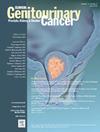转移性去势抵抗性前列腺癌(mCRPC)年轻患者的治疗模式和结果一项澳大利亚前瞻性登记研究
IF 2.7
3区 医学
Q3 ONCOLOGY
引用次数: 0
摘要
介绍和目的年轻患者的癌症发病率正在上升,包括前列腺癌。据报道,在年轻患者中发展的癌症具有更强的侵袭性表型。有必要检查转移性去势抵抗性前列腺癌(mCRPC)的年轻患者。方法对前瞻性收集的多站点澳大利亚前列腺癌电子数据库(ePAD)进行分析,以确定2016年6月至2024年3月期间入组的所有mCRPC患者。我们定义了确诊为老年的患者;55岁为年轻患者(YP),并与其他年龄≥55岁的患者(OP)比较其特征、治疗模式和结局。结果915例mCRPC患者中,59例(6%)为YP。mCRPC的从头转移表现、Gleason评分、肝转移的存在和PSA倍增时间在YP和OP之间相似。在mCRPC的情况下,一线治疗多西紫杉醇(YP为19%,OP为21%;P = 0.72)和ARPI (68% YP vs. 74% OP;P = .31)也相似。YP更有可能接受≥3线mCRPC治疗(YP为37%,OP为23%;P = .016)。从一线治疗开始,总生存期无显著差异(中位41.9 m YP vs 35.1 m OP;人力资源0.73;95% ci, 0.47-1.15;P = 0.17)或ARPI的停药时间(中位数为15.8 m YP vs 14.9 m OP;人力资源0.93;95% ci, 0.61-1.42;P = .75)。年龄& lt;多变量分析显示,55与生存率无独立相关性(HR 0.82;95% ci, 0.52-1.29;P = .38)。结论发展为mCRPC的年轻前列腺癌患者与其他患者没有明显的临床结局。本文章由计算机程序翻译,如有差异,请以英文原文为准。
Treatment patterns and outcomes for younger patients with metastatic castration-resistant prostate cancer (mCRPC); An Australian prospective registry study
Introduction and Objectives
There is an increasing incidence of cancer in younger patients, including prostate cancer.
Cancers developing in younger patients are reported to have a more aggressive phenotype. There is a need to examine younger patients with metastatic castration-resistant prostate cancer (mCRPC).
Methods
Analysis of the prospectively collected, multisite, electronic Prostate Cancer Australian Database (ePAD) was conducted to identify all mCRPC patients enrolled between June 2016 and March 2024. We defined patients diagnosed aged < 55 years as younger patients (YP) and compared their characteristics, treatment patterns and outcomes to the other patients aged ≥ 55 years (OP).
Results
Of 915 patients with mCRPC, 59 (6%) were YP. De-novo metastatic presentation, Gleason score, presence of liver metastasis and PSA doubling time at mCRPC were similar between YP and OP. In the mCRPC setting, first line treatment with docetaxel (19% YP vs. 21% OP; P = .72) and ARPI (68% YP vs. 74% OP; P = .31) was also similar. YP were more likely to receive ≥ 3 lines of therapy for mCRPC (37% YP vs. 23% OP; P = .016). There was no significant difference in overall survival from start of first line therapy (median 41.9 m YP vs. 35.1 m OP; HR 0.73; 95% CI, 0.47-1.15; P = .17) or time-to-treatment discontinuation for ARPI (median 15.8 m YP vs. 14.9 m OP; HR 0.93; 95% CI, 0.61-1.42; P = .75). Age < 55 was not independently associated with survival on multivariable analysis (HR 0.82; 95% CI, 0.52-1.29; P = .38).
Conclusion
Young patients with prostate cancer who go on to develop mCRPC do not appear to have distinct clinical outcomes to other patients.
求助全文
通过发布文献求助,成功后即可免费获取论文全文。
去求助
来源期刊

Clinical genitourinary cancer
医学-泌尿学与肾脏学
CiteScore
5.20
自引率
6.20%
发文量
201
审稿时长
54 days
期刊介绍:
Clinical Genitourinary Cancer is a peer-reviewed journal that publishes original articles describing various aspects of clinical and translational research in genitourinary cancers. Clinical Genitourinary Cancer is devoted to articles on detection, diagnosis, prevention, and treatment of genitourinary cancers. The main emphasis is on recent scientific developments in all areas related to genitourinary malignancies. Specific areas of interest include clinical research and mechanistic approaches; drug sensitivity and resistance; gene and antisense therapy; pathology, markers, and prognostic indicators; chemoprevention strategies; multimodality therapy; and integration of various approaches.
 求助内容:
求助内容: 应助结果提醒方式:
应助结果提醒方式:


